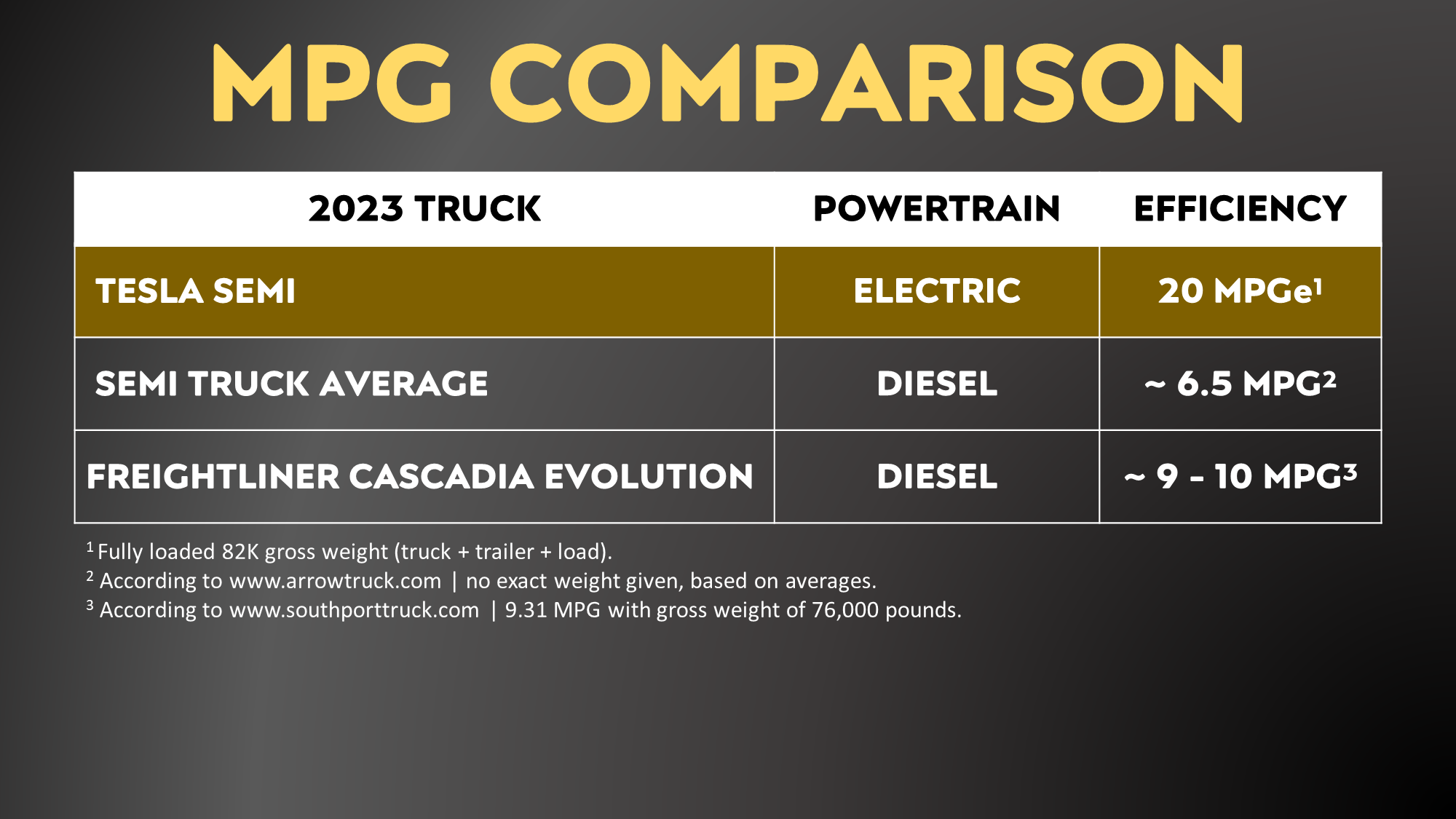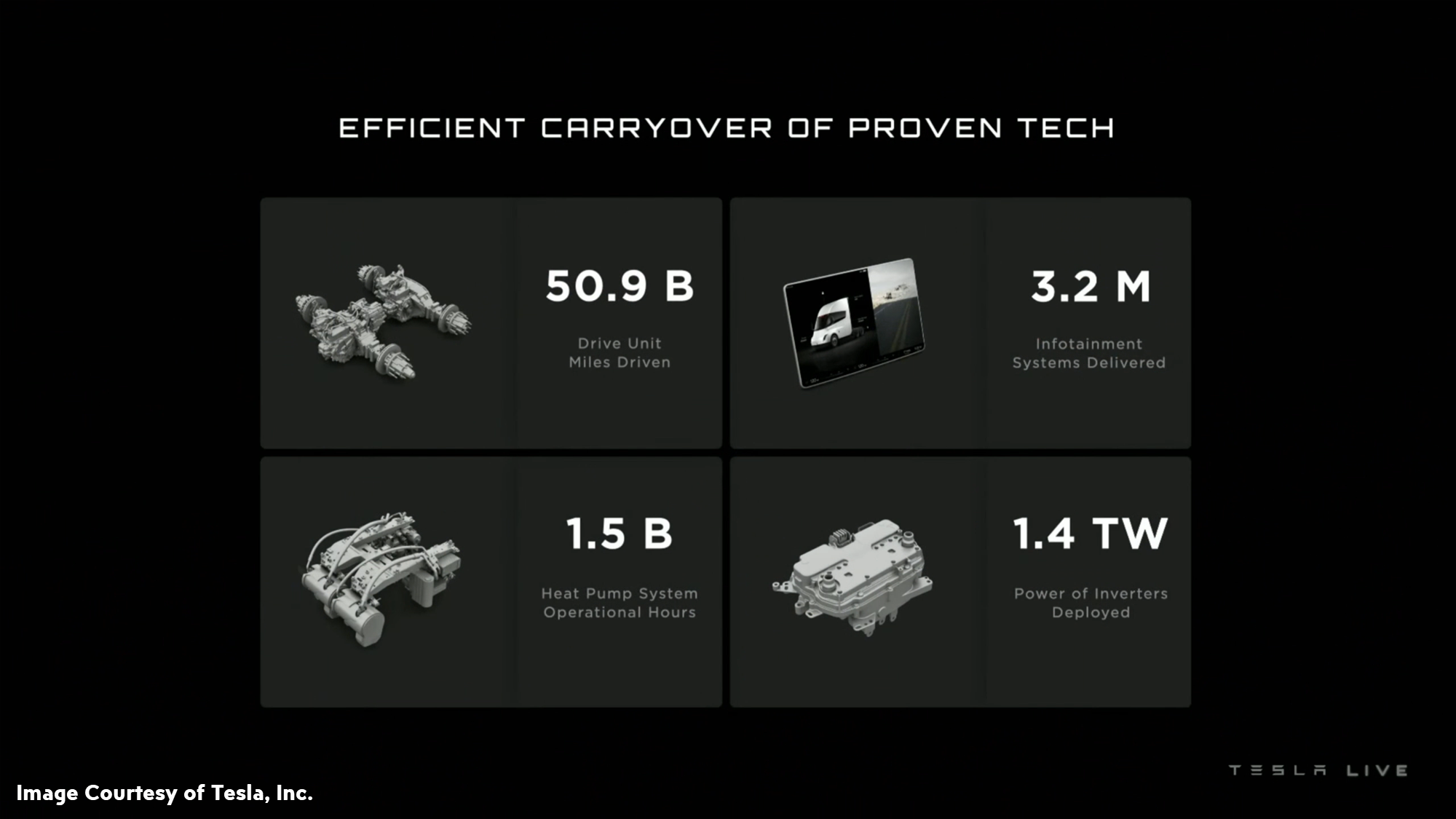INSANE Tesla Semi Truck Efficiency Explained
Although some people doubted that it could be done, Tesla has delivered the first electric semi trucks to Pepsi and one of the most impressive aspects of this Semi is its incredible efficiency. For example, a fully loaded Tesla Semi is actually more than 2 times more efficient than a Ford F-150!
Obviously, when you're talking about a half-ton pickup truck like a Ford F-150, and you're comparing that to a class 8 semi-truck which weighs somewhere around four to five times as much as the F-150, you would expect a gas powered or diesel powered F-150 to be much more efficient. Surprisingly though, the Tesla Semi is actually more efficient.
Courtesy of Tesla, Inc.
At Tesla's delivery event on December 1st, they showed this chart (shown above) which demonstrates how much battery capacity was needed to take a 500 mile real world situation test run all the way from Fremont to San Diego. As you can see, the Tesla semi started out with a 97% state of charge and ended with a 4% state of charge, which means that the Tesla semi only needed 93% of its battery capacity to travel 500 miles. As a reminder, this is with a combination weight of nearly 82,000 lbs. (truck, trailer and load all combined).
Now, there is a big difference between smart range and dumb range, as Lucid's CEO, Peter Rawlinson has brought up in the past. Anyone can throw a bunch of batteries into a vehicle and make that vehicle have a long range, however, the Tesla semi is very efficient in addition to offering impressive range. Yes, it has a large battery pack, but comparable to what it's able to accomplish, it's extremely efficient.
For example, on Tesla's website, it states that the semi requires less than 2 kWh per mile, fully loaded at an 82,000 lb. gross combination weight. Now, of course, less than 2 kWh per mile could mean like 1.99 kWh per mile, however, the electric semi is actually quite a bit more efficient than that. Elon Musk recently tweeted out on December 2nd and mentioned that the current efficiency of the Tesla semi is 1.7 kWh per mile. He also mentioned that there is a clear path to 1.6 and possibly 1.5 kWh per mile.
When you're comparing the efficiency of a gas or diesel vehicle to an electric vehicle, it is a little bit of an apples and oranges comparison, so you actually have to do a little bit of a conversion to get a more comparable number. This is why the EPA has come up with what they call a “mile per gallon equivalent” or MPGe. For instance, if you go to fueleconomy.gov and you pull up the efficiency of an electric vehicle, the main number that you can see is the “mile per gallon equivalent”.
Now, when it comes to calculating a mile per gallon equivalent for an electric vehicle, I found an article on zimbrick.com which explains that one gallon of gas is equal to around 33.7 kilowatt hours of electricity. Thus, as this article explains, an electric vehicle’s mile per gallon equivalent is simple a calculation of the distance a car can travel on 33.7 kilowatt hours of electricity.
“MPGe is the distance a car can travel on 33.7kWh of electricity. So, if a vehicle can cover 60 miles for every 33.7kWh of electricity, its MPGe would be 60. That would be the equivalent of a gas-powered car getting 60 mpg.”
Quote from: zimbrick.com
Thus, if you divide 33.7 kilowatt hours by the 1.7 kilowatt hours, this means that the Tesla semi can travel around 19.82 miles on 33.7 kilowatt hours of electricity. Slightly rounding up, that makes the mile per gallon equivalent of the Tesla semi is right around 20 MPGe. When it comes to comparing the Tesla Semi’s efficiency to several popular pickup trucks, you can see that each one of these trucks is less efficient than the Tesla Semi.
However, keep in mind, that 20 mile per gallon equivalent for the Tesla Semi is fully loaded and 82,000 lb. gross combination weight. The MPG numbers shown above are not for a fully loaded truck, nor do they represent efficiency while towing a trailer. In order to get a more apples to apples efficiency with the Tesla semi, we need to first find out how much lower the MPG goes down with an internal combustion engine pickup truck while towing.
So, in order to get some estimations on this, I found a video on the fast lane truck YouTube channel. In this video; they tested the efficiency of a Ford F-150 equipped with a V8 engine, while towing a £9,000 trailer. While towing that load, this video reveals that that Ford F-150 only averaged around 8.4 MPG. I pulled up the efficiency of a similar 2019 Ford F-150 with a V8 engine, and that truck has an efficiency of around 18 miles per gallon while not towing. In this example, the F-150 loss around 53.3% of its efficiency while towing. Thus, if you take that average loss of 53.3% and assume a similar MPG loss while towing for the rest of these these trucks, the Tesla Semi is likely more than twice as efficient whilst towing as compared to much smaller pickup trucks.
Now, I don't know about you, but that kind of efficiency really boggles my mind! How can you can have a Class 8 semi truck that weighs 4 to 5 times as much as a Ford F-150, yet the semi is more efficient? This is an incredible feat of engineering!
Obviously we're not really in a real world going to compare a half ton pickup truck to a class 8 semi truck, so how does the Tesla Semi compare to similar sized diesel trucks? Well, according to an article from arrowtruck.com, the average diesel semi has an efficiency of around 6.5 miles per gallon. Additionally, one of the most efficient diesel semis on the road right now is the Freightliner Cascadia Evolution. As was pointed out on southporttruck.com that semi was able to average around 9.31 miles per gallon with a gross weight of 76,000 lbs. However, when you compare this to the Tesla semi, it's more than twice as efficient as even the Freightliner Cascadia Evolution.
Now, the MPGe calculation for the Tesla Semi above is as compared to a gallon of gas, but diesel fuel actually stores more energy per gallon as compared to gasoline. Thus, depending on where you get your data, there is between 37.85 to 40.70 kWh of energy stored in a gallon of diesel fuel.
With these new numbers in mind, here is a better MPGe comparison of the Tesla Semi versus the diesel semi truck competition, which actually makes the Tesla semi efficiency look even more impressive.
Battery Pack Size
Now, when it comes to the battery pack of the Tesla Semi, since we know that the efficiency right now is somewhere around 1.7 kilowatt hours per mile, we can estimate that the battery size is at least 850 kWh. However, depending on how much of a buffer that Tesla has built in, the Semi’s pack is likely a bit closer to 900 kWh.
Electric Truck Competition
To be fair, the Tesla Semi is not the only electric truck available in the USA right now. But, as shown in the chart below, the Tesla Semi is the only truck on this list with a range around 500 miles. This puts the Tesla Semi in a whole different league than these other semi trucks and makes the Tesla Semi much more practical. In addition, the range estimates for all of the trucks below except for the Tesla Semi are most likely do not accounting for a full load. Thus, in reality, the Tesla Semi’s range advantage is even more drastic than this chart indicates.
When it comes to some of the factors that make this incredible efficiency possible, there are three basic categories that I want to bring up. Of course, more goes into efficiency than these three categories, but these are three very important categories.
Aerodynamics
When it comes to aerodynamics, the Tesla Semi has a drag coefficient, nearly half that of the average diesel semi. According to an article from notateslaapp.com, the drag coefficient of the Tesla semi is 0.36 as compared to a traditional diesel semi which has a drag coefficient somewhere between 0.65 and 0.70.
Tri-Motor Powertrain
Here's how the Tesla Semi powertrain was described at the Tesla delivery event:
Elon Musk: “We've got a tri-motor powertrain system… we're using the carbon over-wrapped sleeve. So, essentially we're using the plaid model S model X powertrain….”
Dan Priestley: “Yeah, this is really unique. I mean, we are going with a tri-motor system. One of them is constantly engaged. So that's for maximum efficiency. You're getting a highway that's doing the bulk of the work and it's operating at the peak efficiency point of the entire drive train. And then the other two units are for torque acceleration. So when the driver needs it to get their job done, whether that's know, getting out of a loading dock or it's on the road and you pass somebody, you're tackling a grade, you have the torque and power to do it.”
“And the cool thing is that these are clutched automatically. So, no driver input needed, but it's also seamless. So the highway efficiency unit is cruising along doing its thing. And if the driver puts their foot to the floor, the torque units spin up, clutch engages and takes over, and it does all of that before we've maxed out the torque on the efficiency unit. So it's completely smooth. There's no turbo lag or jerkiness or anything like that. No driver input needed. It's smooth both in terms of acceleration and deceleration for re-gen. It's a really cool happening all behind the scenes.”
Elon Musk: “But you can you can basically pull 82,000 lbs. at cruise… and the only thing that's doing that is a tiny little motor, on one axle…”
Quotes from Tesla Semi Delivery Event on December, 1st 2022
Advanced Heat Pump
A thermal management system with a heat pump is much more efficient than a resistive heater and consumes less electricity to take care of the heating and cooling needs of the vehicle. This is especially important during the winter months, when heating the battery pack and the vehicle cabin can consume quite a bit of energy, and often leads to a loss in available range during colder weather. The heat pump in the Tesla Semi should help limit winter range loss.
Charging Speed
Being able to travel somewhere around 500 miles on a single charge is incredible. But on top of that, the Tesla semi charges quite quickly as well. On Tesla's website they quote that you can charge up to 70% of range in 30 minutes. And this, of course, will be achieved on Tesla's new V4 Superchargers, which put out one MW plus of DC charging power.

















